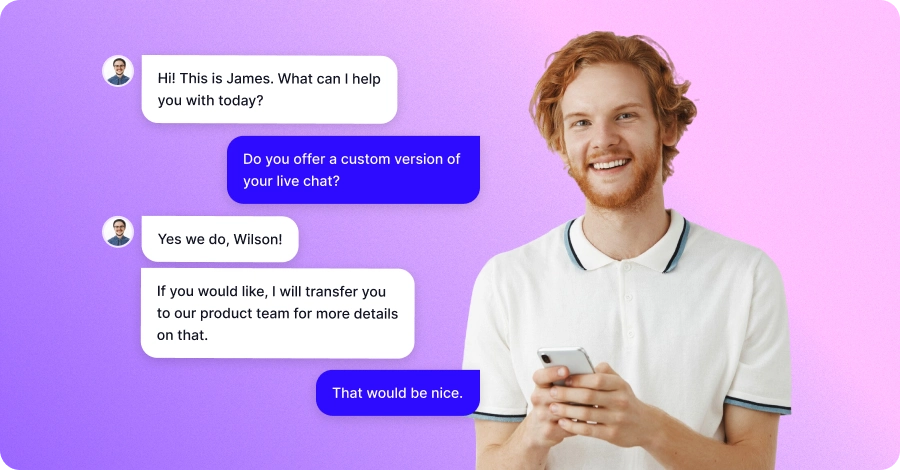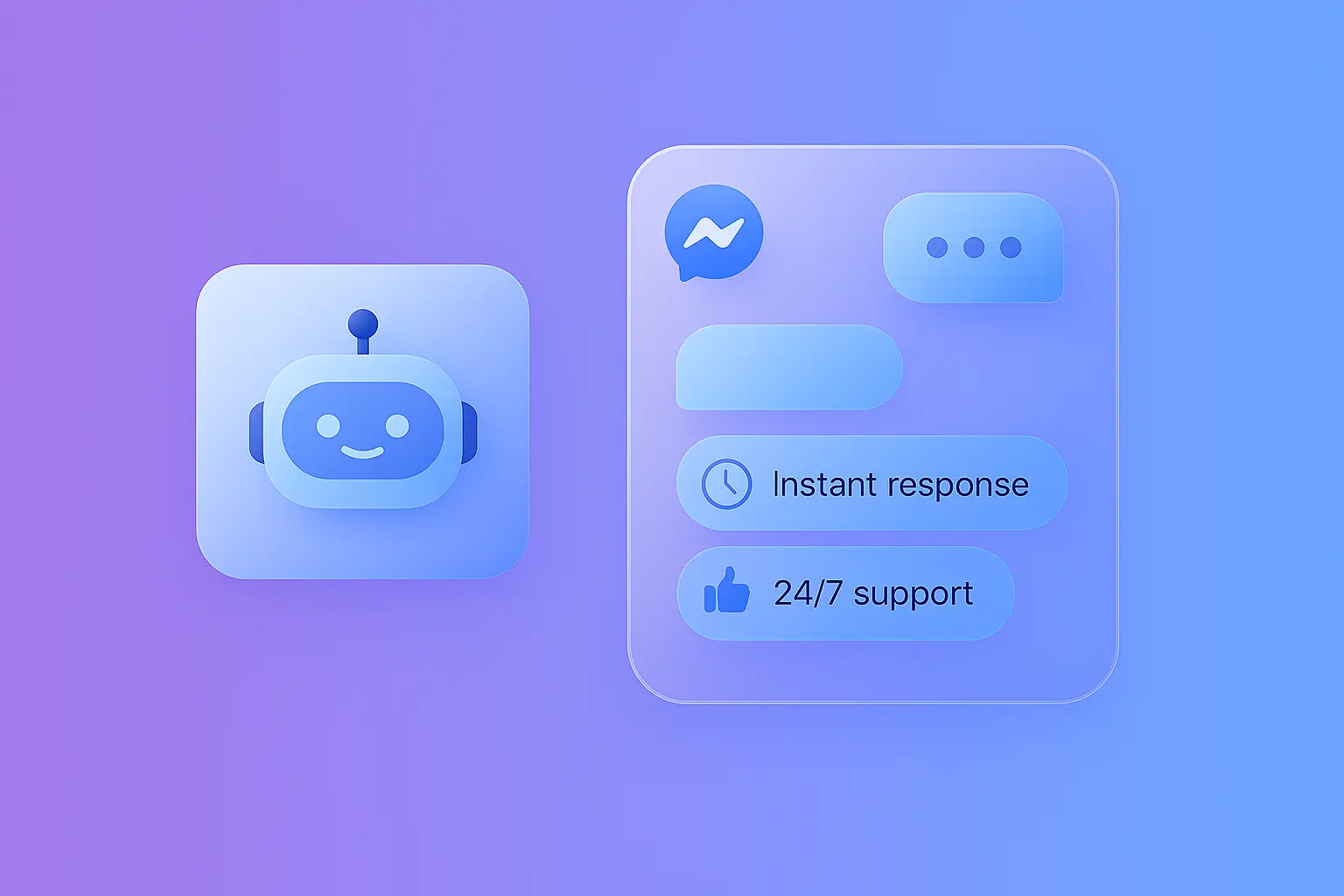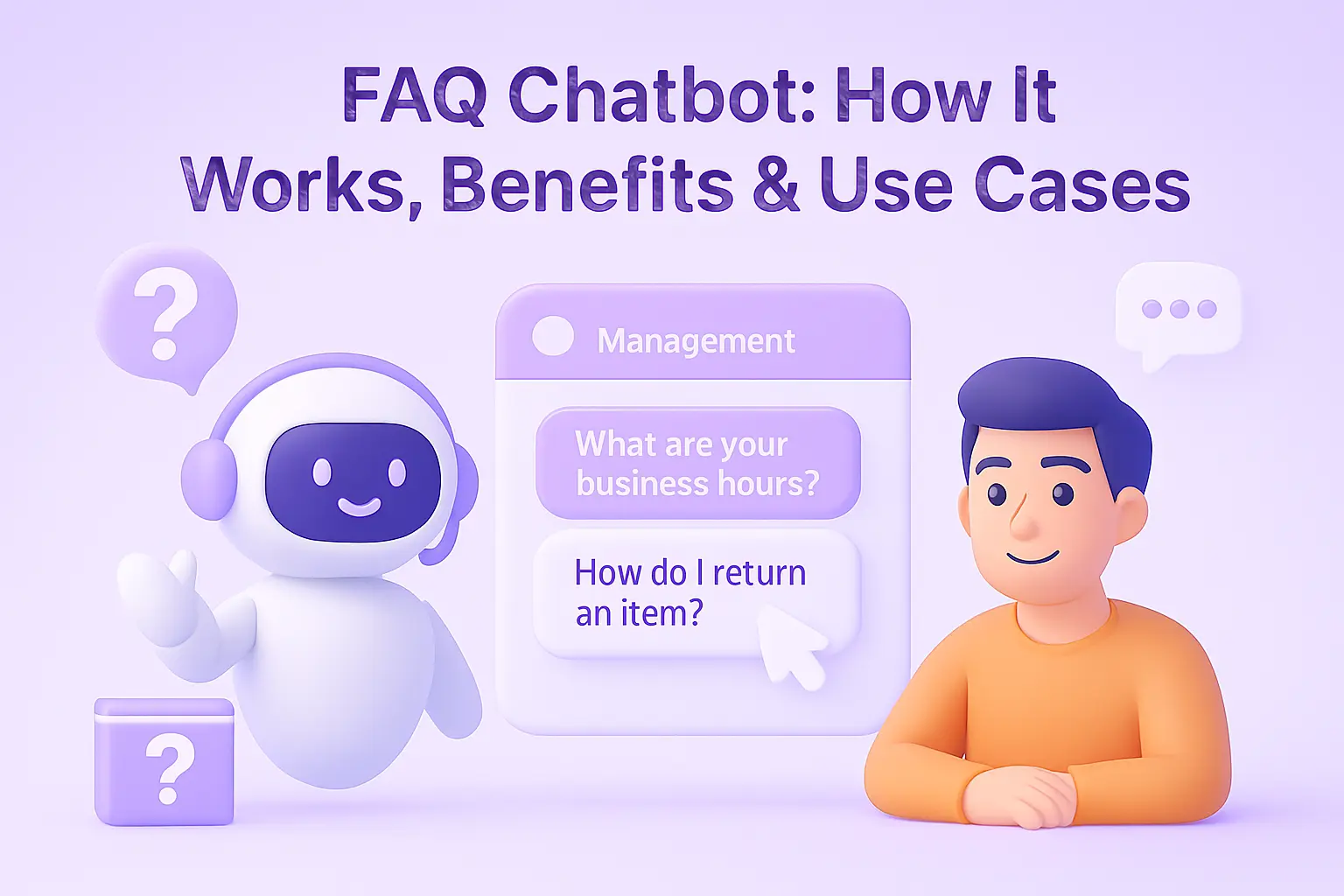Real-Time Communication: Connecting People in a Digital World
- April 27, 2023
- 12 mins read
- Listen

“Patience is a Virtue”, many of us know this phrase. But will your customers be fine with it if you make them wait for hours to resolve their issues or reply to their queries?
The answer will be a big ‘NO.’ In this fast-paced world, for online communication, everyone expects an immediate response and that’s why Real-Time Communication (RTC) comes into the picture.
Real-time communication didn’t develop overnight. It first began with the telegraph and then evolved to the telephone, and later led to a new era of real-time chat interactions.
So, what’s RTC all about? Is it really helpful for businesses? What are the different types and RTC tools? In this blog post, I will explain everything. So, keep reading!
What is Real-Time Communication?
Let’s look into the definition first!
“Real-time communication (RTC) refers to a form of online communication that allows users to interact with one another in real-time without any significant delay. With RTC, information is transmitted instantaneously between senders and receivers, even across vast geographical distances, without being stored or buffered at any intermediate points.”
In technical terms, RTC involves live telecommunications without any transmission delays, typically utilizing a peer-to-peer connection that minimizes latency. Real-time communication applications facilitate the direct transmission of data between the source and destination, without intermediaries or buffering along the way.
Real-time communication has become increasingly vital in today’s fast-paced economy, where we always expect an instant response.
This technology has revolutionized the way we interact and share information, turning the world into a global society where communication and data exchange occurs at lightning speed, regardless of distance.

A History of Real-Time Communication: From Morse Code to Modern Technology
RTC was first introduced to the general public in America with the development of the public switched telephone network (PSTN) in the early 1900s, which brought about a significant transformation in long-distance communication.
In 1915, the launch of a transcontinental telephone line marked a historic moment, as it enabled users located over 3,000 miles apart to engage in interactive conversations as if they were physically present in the same room.
Real-time communication underwent further revolutionary changes in the latter part of the 20th century, thanks to the advent of smart devices, high-speed internet connection, and mobile telephony.
These technologies enabled the development of new modes of communication, such as instant messaging (IM), video calls and conferences, Internet Protocol (IP), and more.
RTC technology reached another significant milestone in 2011 with Google’s release of the open-source WebRTC project. WebRTC utilizes JavaScript application programming interfaces (APIs) to facilitate peer-to-peer (P2P) audio and video communication directly within web browsers, without requiring any special plugins or standalone applications.
Examples of Real-Time communication
Emailing and chatting are two distinct forms of communication. Email is a time-shifting mode of communication where the expectation is to send messages and receive responses later, and data is stored between the sender and receiver.
Email communication prioritizes delivering information reliably rather than how fast it reaches there. In contrast, chatting involves real-time communication where we expect instant responses as if we were interacting face-to-face. This is just one example to make you understand the concept. Now let’s look into other forms of RTC.
1. Voice calls and Video Chat
Voice and video chat enable users to have a peer-to-peer interaction experience, regardless of their physical distance, and are effective in personalizing communication between parties.
Whether it is for customer service, dating, advisory services, healthcare, or concierge services, integrating online chat service into your app helps you to provide personalized services, leading to increased engagement and customer retention.
2. Chatbot
It’s an AI-powered computer program that lets your customers get instant assistance on your website, mobile app, or even other messaging platforms. It automates your customer support and other business operations and frees up your support team to concentrate on other complex tasks.
Chatbots can be programmed to understand natural language and respond to users in a conversational manner, providing assistance or information on a range of topics.
3. Live Chat
Live chat is an example of real-time communication that enables users to interact with customer support representatives, sales representatives, or other users in real-time via text-based messaging.
You can easily integrate live chat into your websites, mobile applications, and other social media platforms, to offer quick and efficient service to your customers.
4. Live Broadcast
The live broadcast is a real-time communication tool that allows users to transmit live audio and video content over the internet to a remote audience. It is a form of live streaming that enables users to share experiences, events, or messages in real-time.
The live broadcast is commonly used for broadcasting live events, sports matches, news, concerts, or conferences. It provides a sense of immediacy and engagement, allowing users to connect with their audience in real-time and interact with them through comments, polls, or Q&A sessions.
5. Instant Messaging
It is another great real-time communication tool that enables us to send and receive text messages over the Internet. It allows users to have private or group conversations with other users who are also online, creating a sense of immediacy and interactivity.
Instant messaging has become increasingly popular as a tool for personal and business communication, as it provides a quick and efficient way to exchange information and stay connected with others.
6. Social Media
It allows us to connect with each other online and share information, ideas, and interests. Social networking platforms such as Facebook, Instagram, LinkedIn, and Twitter have become popular ways among us to build relationships, find new opportunities, and stay connected with our friends and colleagues.
Social networking has many benefits for different businesses too including facilitating communication and collaboration, building professional networks, promoting brands, and creating brand awareness.
Benefits of Real-Time Communication
Undoubtedly, real-time communication has become an essential aspect of our lives, both personally and professionally, as we can easily connect with our loved ones through instant messaging, voice calls, live video calls, and so on. In addition to this, people also acknowledge other advantages of real-time communication such as:
Instant Response
Real-time communication enabled individuals to make faster decisions with just one swing, as there was minimal response time from peers and no interruptions or delays. This resulted in efficient response management and improved overall agility.
In situations where time is of the essence, such as in emergency response scenarios or time-sensitive business deals, instant response through real-time communication can be particularly valuable for both business and personal purposes.
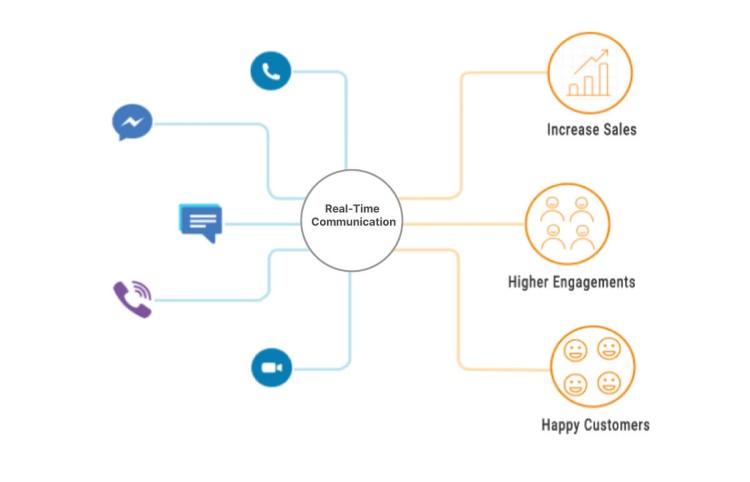
Secured
It provides a secure platform for individuals and teams to exchange information and collaborate in real-time. This is particularly important when we deal with sensitive or confidential information, as it helps to ensure that data remains secure and protected from unauthorized access.
Real-time communication platforms often come equipped with security features such as end-to-end encryption, two-factor authentication, and access controls, which help to ensure that data is only accessible by authorized users.
Following the Covid-19 pandemic, when many companies shifted to work from home jobs, the use of real-time communication (RTC) technologies experienced a surge, particularly with the availability of video conferencing options.
Currently, many businesses continue to utilize group calling methods due to their secure nature, resulting in increased employee satisfaction and productivity.
Connect from Anywhere
Web real-time communication provides the prime advantage of remote access, enabling us to connect from any location across the globe. Regardless of whether you are in a car going to the office to drop kids off at school, real-time communication offers a mode of interaction that is both convenient and free from delays.
This can be beneficial for different businesses where you need to collaborate with your remote colleagues, or when working on projects that involve team members from different geographic regions.
By enabling us to connect from anywhere, real-time communication helps to break down barriers to collaboration and promotes more seamless and efficient communication.
Increased Efficiency
Real-time communication also provides the benefit of increased efficiency, allowing us to exchange information and collaborate in real-time. This can help to reduce delays and bottlenecks in communication, which can often occur with other communication methods such as email or messaging.
As we can communicate in real-time, issues are addressed quickly, and decisions can be made faster. This can result in increased productivity, improved customer service, and a more agile and responsive organization.
Additionally, real-time communication can help you to reduce the need for in-person meetings or travel, which can save time and resources for both individuals and your company.
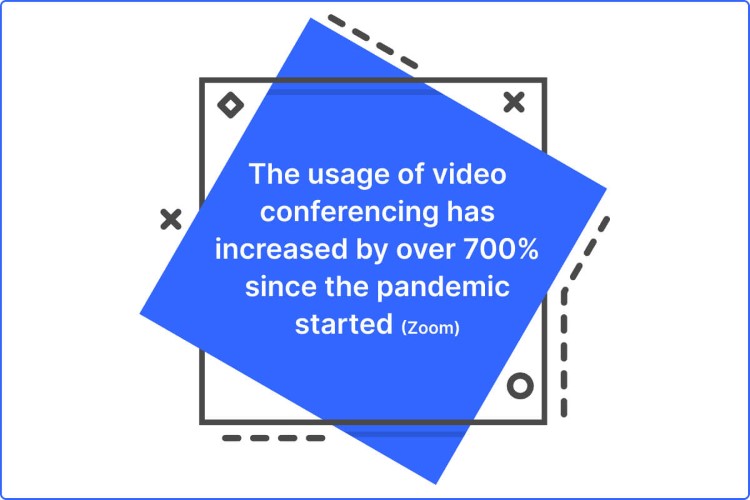
What is WebRTC?
When it comes to Real Time Communications, a buzzword you may encounter is WebRTC. WebRTC, which stands for Web-based Real Time Communications, is an HTML5 technology that fulfills the potential of real-time communication by enabling peer-to-peer connections for plugin-free communication via a web browser.
WebRTC is supported by several popular web browsers including Chrome and Opera. Developing a WebRTC application involves using three key APIs: getUserMedia (MediaStream) for accessing data streams like a camera or microphone, RTCPeerConnection for secure audio or video calling with bandwidth management features, and RTCDataChannel for peer-to-peer data communication.
WebRTC is widely used for web conferencing, online gaming, remote education, and telehealth, among other applications.
Real-Time Communication Tools
Real-time communication (RTC) tools are software applications that enable us to communicate and collaborate with others in real time over the Internet. These tools can be used for a variety of purposes, including remote work, online learning, customer support, and socializing with friends and family.
There are many different types of RTC tools available today, each with its own unique features and benefits. Let’s discuss it!
Instant Messaging
Instant messaging (IM) allows us to send and receive text messages, multimedia content, and files in real time over the Internet. IM tools are commonly used for team collaboration, customer support, and social networking.
Some popular examples of instant messaging tools include WhatsApp, Slack, Facebook Messenger, and Microsoft Teams. Each tool has its own unique features and benefits, so it’s important to choose the one that best fits your needs and goals.
Voice Calls
Voice calls enable users to make phone calls over the Internet using Voice over Internet Protocol (VoIP) technology. VoIP is a method of transmitting voice communications over the internet, rather than traditional phone lines. VoIP technology is often cheaper than traditional phone lines, making it a cost-effective option for businesses and individuals.
Some popular examples of VoIP tools include Skype, Zoom, Google Voice, and WhatsApp.
Live Streaming
Live streaming is a type of real-time communication tool that allows us to transmit live audio and video content over the internet. Live streaming is commonly used for events, webinars, podcasts, and other types of online broadcasts.
It enables real-time communication between the broadcaster and the audience, making it possible to engage with viewers in real-time.
Many live-streaming platforms include interactive features such as chat rooms, polls, and Q&A sessions, making it possible to engage with viewers and create a sense of community.
Some popular examples of live streaming platforms include Facebook Live, YouTube Live, Twitch, and Periscope.
Chatbots
AI chatbots are great real-time communication tools for companies who want to offer best-in-class customer service and automate many of their operational tasks for better productivity and cost savings.
Through chatbots you can be available 24/7, making it possible to provide instant support and assistance to your customers at any time. As it can handle a large volume of inquiries and requests at once, the chatbot serves a large number of customers simultaneously.
You can also configure your chatbot to provide personalized responses based on customer data and preferences, making it possible to provide a more tailored customer experience.
Some popular examples of chatbot platforms include REVE Chatbot, Chatfuel, Tars, ManyChat, and MobileMonkey.
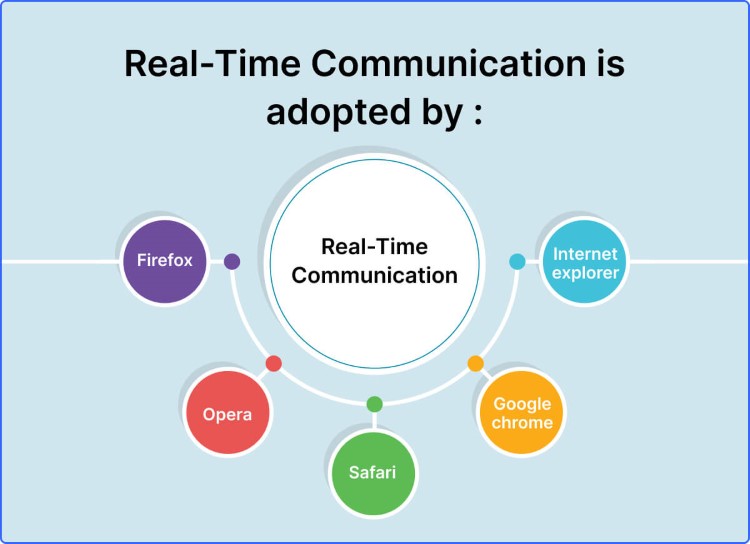
Real-Time Communication – The Future
The definition of real-time communication keeps on changing, and there are numerous trends that will have a significant impact on its development in the coming years.
One of these trends is the growing use of WebRTC, which allows HTML5-enabled browsers to use real-time communication technology without requiring a third-party plug-in.
As we have started using real-time communication more on mobile devices, there is a growing concern about the strain it puts on networks. The current emphasis is on finding ways to efficiently scale these networks and enhance their security measures.
The growth and development of Over-The-Top (OTT) services have also increased significantly. Platforms such as Netflix provide direct consumer services over the Internet, bypassing traditional distribution channels such as cable and phone networks.
Furthermore, advances in artificial intelligence (AI) and natural language processing (NLP) will enable chatbots and virtual assistants to become more sophisticated and personalized, providing users with more natural and intuitive ways to interact with technology.
Overall, the future of RTC will likely involve more integrated and seamless communication experiences, with a greater emphasis on security, privacy, and personalization. As technology continues to evolve, we can expect even more exciting developments in the world of real-time communication.
Over to You!
Real-time communication (RTC) tools have revolutionized the way we communicate with each other. From instant messaging to voice and video calls, live streaming, and chatbots, these tools have made it easier than ever before to connect with people from around the world.
With the rise of remote work and the need for virtual collaboration, RTC tools have become an essential part of our daily lives. As technology continues to evolve, we can expect even more exciting developments in the world of RTC, which will undoubtedly shape the way we communicate and interact with one another in the future.

